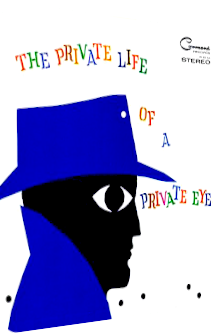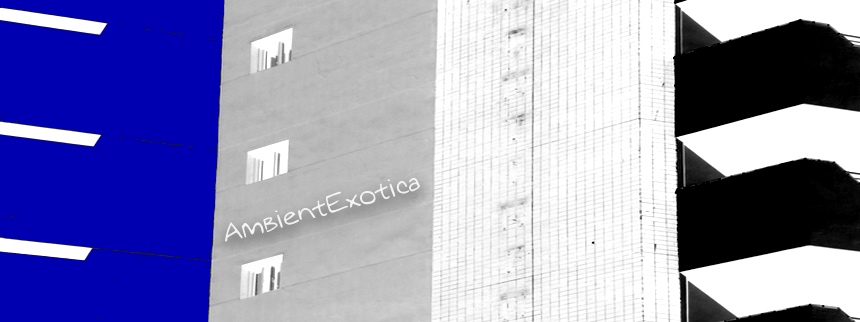
Enoch Light
The Private Life
Of A Private Eye
1959
Whenever I am reviewing a work of bandleader and recording engineer Enoch Light (1907–1978), chances are that I need to justify – even to myself – the addition of another record to the —Exotica Review Archive— that’s foreign to the species. That Light didn’t even create one single Exotica record in the utmost strictest sense of the term doesn’t hold me back. No, it is the linkage of his name to the audiophile craze that lets me ponder more often than not about dozens of his records. While they are always flawlessly arranged with the best equipment money could buy at the time and feature world-renowned Jazz luminaries in lieu of mere session musicians, chances are that the aura of stereo immersion, quadrophonic sound and interpretations of evergreens and soon-to-be Rock classics create a vertiginous zoetrope of opportunities forcefully created in order to cash in.
Not so on The Private Life Of A Private Eye, inarguably Enoch Light’s greatest and most imaginative record. Released in 1959 on his own Command label, it features 12 stupefying original cuts of the Crime Jazz/Spy Jazz era supercharged with bone-crushing timpani, eclectic percussion (with bongos and congas!), towering brass fusillades, mallet instruments and flittering pianos in raunchy bars. Composed by Light and his longtime collaborator Lew Davies, The Private Life Of A Private Eye breathes and lives excitement and danger, both of which come with an ever-important twist: accessibility and friendliness. The depicted city isn’t an underground-infested cesspool after all, but aglow with helical tendrils, sylphlike segues and lots of good-natured strata. This is not necessarily what the truly interested Crime Jazz fan has in mind, but even though every quasi-dangerous situation is channeled through gossamer tunnels and cross-fading vestibules, this album transpires plenty of fun.
Danger and death are a private eye’s best buddies, that is if Hollywood offers realistic portrayals of the daily routine, which it usually does. Right. All the more surprising and downright enchanting is the eponymous opener which is not situated in film noir territory. No, Enoch Light offers a vibrant technicolor explosion instead. After the rolling cascade of drums, stellar-vivacious brass profusions hammer their gleeful punctilio into the already suave mélange of glistening pianos, dreamy guitars and sizzling hi-hats. The wealth and scope of this kick-off is awe-inspiring, it feels like the opener to a film ablaze with florescent splashes. All is well in the world if this approximates a private eye’s circadian flow. The adjacent Gang At The Green Grotto breathes danger in its title only, as the bongo-fueled faux-Prohibition Era timbre and Honky Tonk piano peritoneum offer an exciting atmosphere even in midtempo form. The meanest brass stabs are still bright and friendly enough to make this one a breeze.
With Harry’s Hideout, Enoch Light succumbs to the genre’s true conventions and tones down the hue in favor of interstitial shadows and twilights. Suspense is in the air as marimba-accompanied brass layers scythe through a laid-back locale that is as keen on darker tones as it is prone to let silence cover the frequencies. Short accordion bursts and the constant silk of hi-hats round off a dubious but ultimately jovial stash. Dirty Work Underfoot then lets much darker brass fanfares clash with their brighter counterparts, resulting in a cavalcade of blazing stardust and flying sparks before the second half celebrates the return to shifty hole-and-corner crannies. Frenchy’s Tune meanwhile offers a rustic harbor ambiance of Dominic Cortese’s accordion percolations around whose melancholic aura oneiric glockenspiels and alto flutes are dancing. A wonderfully contemplative vignette. Harlem Hot-Shot In A Hurry is of course anything but hectic: a cloak-and-dagger wild chase with aureate brass screeches and glaucous marimbas, this tune means serious business, albeit transfigured into delightful tone sequences that become increasingly sparkling and show tune-like as the composition progresses.
Side B is equally successful in transporting the multifaceted emotions and phylogenetic basics of this professional group we know as private eyes. Blonde Bombshell is the expected femme fatale theme, but in lieu of shady chromaticity, the lady is brought into the limelight of a bustling club. Easygoing guitars, towering trumpets and pianos in martelato style transform mystery into glee. Likewise, Mess In Morocco basks in good-natured brass hooks, Chinese gong leeways and half-Oriental tonalities embroidered throughout the second half, breaking the Western megacity mood for a moment or two.
The Creep is more of an elasticized Dixieland shadow with lots of dubious tone sequences and umbrageous corners to hide in, whereas Serenade For A Sweet Babe offers a dreamy piano arrangement with additional trumpet helixes and thus an enchanting moment of rest. While Living On Borrowed Time celebrates the return to form as Enoch Light unfurls glistening brass bursts full of rapture and elation amid a galloping beat, Gum Shoe Lullaby offers one final moment of Hollywood-esque flowerage and joy; only in the distance are the devilish tone sequences allowed to percolate, but it is to no avail, as The Private Life Of A Private Eye ends in a kaleidoscope of colors.
Make no mistake, whether you’re an Exotica fan, Spy Jazz aficionado or actual detective: The Private Life Of A Private Eye sees Enoch Light at his peak and offers a gorgeous mélange of Crime Jazz and show tune craftsmanship that is enjoyable from the very first second until the last. Great melodies and catchy hooks meet super-polished textures and a cinematic wideness that lets you feel the capaciousness of the big city. The occasional fibrillar surfaces allow moments of reflectiveness before the eclectic thrill of the bustling district captures both the attention and imagination yet again. Followers of the genre will likely complain that mood and atmosphere are waaaay too friendly and harmless, lacking the acidic pressure and thrilling near-death experiences which this kind of music is able to invoke so formidably. This is indeed a flaw that cannot be denied.
On a more positive note though, said flaw is at least permanently ostracized throughout the runtime; there is not one single composition that is truly baneful and virulent. If this were the case, I could understand that followers would want this singular moment featured in the remaining eleven arrangements as well. But no, horror and threatening thrills are completely banished, making The Private Life Of A Private Eye a family-friendly affair of a recording engineer who delivers a fantastic string of coherent vignettes, motifs and sections. This is not (yet) the Enoch Light audiophiles got to know and love. Here, unique compositions and glorious melodies are reigning over the city and become the actual stars. Thankfully, this has been duly noted, and that’s why The Private Life Of A Private Eye is not just available on vinyl, but a remastered digital version by AMR Sinetone as well. Give it the proverbial spin: you might adore it!
Exotica Review 411: Enoch Light – The Private Life Of A Private Eye (1959). Originally published on Jan. 31, 2015 at AmbientExotica.com.
